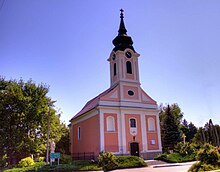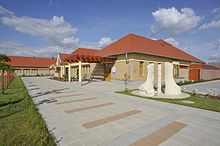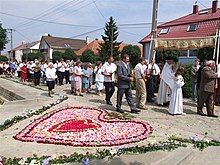Újhartyán
| Újhartyán | ||||
|
||||
| Basic data | ||||
|---|---|---|---|---|
| State : | Hungary | |||
| Region : | Central Hungary | |||
| County : | pest | |||
| Small area until December 31, 2012 : | Dabas | |||
| Coordinates : | 47 ° 13 ' N , 19 ° 23' E | |||
| Height : | 110 m | |||
| Area : | 22.43 km² | |||
| Residents : | 2,759 (Jan 1, 2011) | |||
| Population density : | 123 inhabitants per km² | |||
| Telephone code : | (+36) 29 | |||
| Postal code : | 2367 | |||
| KSH kódja: | 06293 | |||
| Structure and administration (status: 2014) | ||||
| Mayor : | József Schulcz ( Fidesz ) | |||
| Postal address : | Fő u. 21 2367 Újhartyán |
|||
| Website : | ||||
| (Source: A Magyar Köztársaság helységnévkönyve 2011. január 1st at Központi statisztikai hivatal ) | ||||
Újhartyán [ ˈuːjhɒrcaːn ], German Hartian , is a town in Pest County in Hungary .
geography
Geographical location
Újhartyán is located in Pest County, in the geographical center of the country. The small town is about 40 kilometers south of Budapest next to the M5 motorway.
geology
Just like the surrounding communities and large parts of the capital, Újhartyán is located in the northwest of the sedimentary basin of the Great Hungarian Plain .
history
Újhartyán until 1990
In 1276, a bull from Pope Innocent IV mentions a settlement called villa Harquian , which was about one kilometer south of today's town center. The name probably comes from the word horka , which denoted a princely judge. This thriving medieval community of Hartyán perished completely in 1597 during the Turkish War of Conquest, as did many other villages in the area. The area became a deserted puszta .
After the Turks were driven out, Pál Ráday bought the area and sold it to Count Antal Grassalkovich I in 1731. It was the only settlement in the region that Antal Grassalkovich did not let go, but rebuilt. He began building a village in 1764 with a regular, parallel network of roads and encouraged Hungarian, German and Slovak settlers to settle with donations of land. The latest research has shown that the settlers did not come directly from Germany, but from the nearby Swabian settlements, such as Harast , Taks and Schorokschar . The common original home with these settlements is the district of Donau-Ries, among others the places Gremheim, Blindheim, Tapfheim, Donaumünster, Schwenningen and Binswangen.
Initially, there was a strong Slovak population group in addition to the German population. After a wave of emigration, the village became primarily German and strictly Catholic. The breeding and economic customs were adopted and preserved from the German territories. The population was always proud of their religion and the musical and gastronomic customs they had brought with them from Germany. In 1776 the Catholic church was built in the baroque style, from 1781 the local school, so that this culture was passed on to the following generations. The German language lasted until the middle of the 20th century.
The pressure to assimilate and the political conditions after the Second World War, however, caused the German-speaking school to be closed. In addition, the Swabian population was threatened with deportation. More than 300 Swabians were forced to do málenkíj robot , forced labor, in Ukraine. The strictly closed community gradually lost its mother tongue. After the system change, German nationality was brought to the fore again.
Progress since 1992
- 1992 sports hall
- 1993 telephone network
- 1995 sewage treatment plant
- 1996–97 Expansion of the water network and sewerage, waterworks
- 1999–2001 asphalting of the roads, expansion of the German elementary school with an award-winning building, expansion of the uniform street scene in Szép Street, construction of the sidewalk in Hunyadi and main streets
- from 1999 expansion of the industrial park and infrastructure to 24 hectares, today's industrial area covers 86 hectares (as of 2013)
- 2004 Construction of the health center and expansion of the inspection system in the four settlements of Inárcs, Kakucs, Újlengyel and Hartian
- 2006 construction of the village center
- 2009 German Kindergarten Kinderburg
- 2011 recultivation of the landfill
- 2012 Energetic development of the primary school
- In 2013 the Hungarian President raised the municipality to the rank of city
- 2013 Grassalkovich Square
- 2014 Settlement Monument - for the families who settled Hartian 250 years ago
- 2014 Owl's Nest craft house and youth hostel
- 2015 Reconstruction of local history museum, memorial to those who were abducted
- 2016 Extension of Grassalkovich Platz with the Grassalkovich Monument and Ulmer Schachtel, new ring traffic
- 2017 Presso Square, new Presso , entertainment center for young people
Religions
95% of the population of Újhartyán belongs to the Roman Catholic Church.
politics
Town twinning
Újhartyán is twinned with Freiberg am Neckar . Unofficial friendships exist with Tapfheim and Bad Nenndorf
Culture and sights
Buildings
- The Roman Catholic Church of Saint Barbara , built in 1776, is on the main street .
- On the outskirts of the community is the St. Mary's Chapel, built in the 19th century and damaged in the Second World War.
- In the forest of Pódtharaszt near the municipality are the ruins of the Heidenkirche . This is the only remnant of the former market town of Pódtharaszt.
- The new village center, built in 2006, with event rooms, an inn and a hotel, is the municipality's youngest public building.
- Opposite it is the 1935 Memorial to the Fighters of the First World War, a work by the artist Béla Farkas .
- The clown masts , two high-voltage masts on a 220 kV line that look like two clowns
music
The population of German descent in Újhartyán is closely connected to their musical tradition. Music and singing have always been part of the work. Music dynasties grew over the centuries. The love for instruments, sheet music and traditional brass music was passed down from father to son. The German self-government, founded in 1998, supports a number of bands, including the united brass band, the youth brass band, Sváb Parti and Presso Band . Most musicians attended or are attending a music college or college.
Folk dance
In 1991 the adult dance group Hercel was founded. Its members have different professions and belong to different age groups. They had numerous appearances in Újhartyán, in Hungarian-German villages and abroad. They represented Hungary at Expo 2000 . The dance group is usually accompanied by the Sváb Parti brass band . The composition changed over the years. Nowadays the founders are already dancing with their children.
Also in 1991 the children's dance group was founded in the school. Since then, hundreds of students have learned the traditional dances of the Hungarian Germans, hops , polka and waltzes.
education
German kindergarten Kinderburg
The kindergarten Kinderburg in Hartian is located in the middle of the city. It was built in 2009 and meets modern standards. The building was constructed for a total of 180 children in 8 groups. The kindergarten building has a kitchen for 400 people and is equipped with modern technology. The air conditioning and heating is provided by renewable energy sources using a geothermal water pump. The building is free of obstacles. An important part of the kindergarten is the secure play area surrounded by masonry. The educational program is activity-centered. It focuses on the Hungarian-German upbringing of children. This is intended to strengthen the Hungarian-German nationality in the city. The pedagogical mediated by professionally trained staff and educators.
German elementary school Hartian
The German primary school has existed since 1998 with 260 pupils. From the first grade onwards, German is taught five hours a week. The school is known for its nationality classes and is also attended by students from the surrounding communities. The students get to know two languages and two cultures. In a playful way you will get to know the story, the songs, the dances, the music of Hartian and Hungarian Germanism. You take part in programs that preserve tradition, for example the Schwabentag, the carnival festival with the Lame Thursday , the lantern parade and Lucien's day. German-speaking camps are organized in the forest every year. Students can travel to Germany and Austria annually.
The current award-winning school building was built in 2000. In 2012 its energy technology was renewed. The building was equipped with a modern heating system and solar systems.
German nationality self-government
The German nationality self-government aims to ensure that the Újhartyáner get their Hungarian-German identity. In the 2011 census, 1,088 out of 2,685 inhabitants identified themselves as Hungarian Germans. Through a variety of events, she tries to strengthen this sense of identity and to advertise it externally. Examples of such events are:
- the bundle ball for pensioners;
- the Schwabenball with a cultural program and Swabian food;
- Passion plays and processions before and at Easter;
- the Corpus Christi procession ;
- the town festival in summer;
- the Hartian festival , the grape harvest festival and the autumn fair ;
- Events in Advent and Christmas.
Economy and Infrastructure
traffic
Due to its proximity to the M5, Újhartyán is easy to reach by car. About every hour, during rush hour every half hour, a bus leaves for Budapest. Travel time on this public bus to Budapest city center is around an hour.
Innovations
An industrial park creates jobs for the city. In 1999, the expansion of the industrial park to 24 hectares began; today's industrial area already covers 86 hectares.
Personalities
- Edit Surman - famous ceramicist
- Ferenc Závodszky - artist
- Benő Fajt - "Bicycle King" from Újhartyán
swell
- Újhartyán Zsebkalauz , multilingual, illustrated fold-out brochure from the municipal administration, Forrás Kiado, 2006
- Oral lecture by the mayor on September 2, 2006 to visitors from Freiberg am Neckar
- Újhartyán-Hartian , brochure of the municipality, 2012
- Martin Majeczki, Katalin Ruttersmid: 2013: A milestone in Hartian's life
Individual evidence
- ^ Photo of the masts in the Daily Telegraph , accessed October 24, 2012












